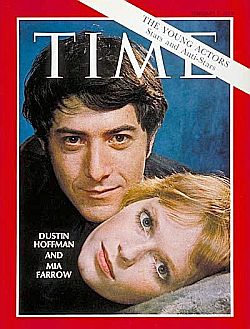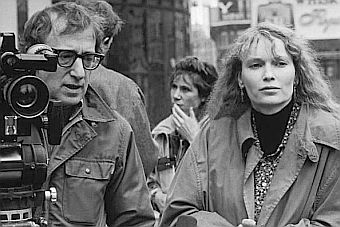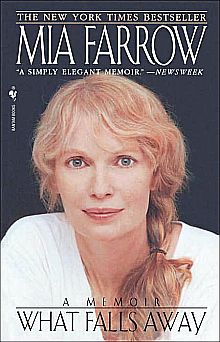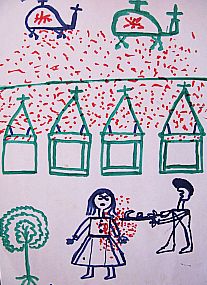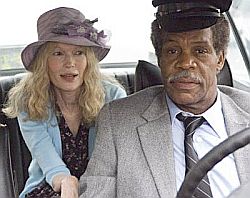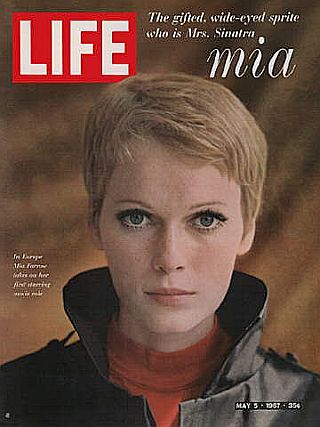
Mia Farrow, as photographed by Alfred Eisenstaedt for the May 5th, 1967 cover of Life magazine. Click for copy.
In late 2010 as this is written, Mia Farrow is far removed from that other time; she is now more activist than actress. But for most of her life, while growing up, and for the next 40 years or more, Mia Farrow lived in the celebrity spotlight — Hollywood parents, her own TV and movie fame, marriages to Frank Sinatra and Andre Previn, a relationship with Woody Allen, and most recently, notice as an international activist. A good part of Mia Farrow’s life in recent years has been given to the plight of others less fortunate, beginning with her own assembled family of 14 children, ten of whom are adopted, some with special needs.
Mia Farrow the international activist, meanwhile — quite the hard-charging strategist and political activist when she needs to be — has been working on behalf of various causes, sometimes on her own and also through the United Nations.
But who is that person with the powerful, mesmerizing eyes looking out at the world from the cover of Life magazine in May 1967? And how has she come to where she is now? A portion of her story is offered here; a life, it appears, full of twists, turns and metamorphoses, moving from comfort and privilege to doing for others in both large and small ways.
Movie Sets & Polio

January 1933: Actress Maureen O’ Sullivan, Mia Farrow’s mother.
“…When I was nine, I got polio. And I was taken from the security of my family into another world, the Los Angeles General Hospital wing for contagious diseases. It was in the middle of the polio epidemic. I was shown sickness, and uncertainty, and pain, even death. Then I was released from that and dropped back into my life, and I never felt quite the same. It gave me a sense that I had to find a life that was meaningful, and that very definitely has shaped the family that I have. I’ve adopted ten children, most of them with special needs, including one son who is paraplegic as a result of polio. So this is my way of addressing that, sort of over and over…”
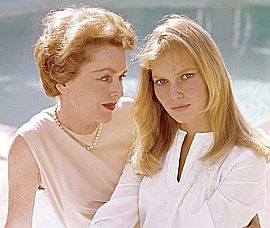
Young Mia Farrow with her mother, 1960s.
Mia Farrow then appeared in a 13-minute film short, The Age of Curiosity, a film profile about the modern teenage girl for Seventeen magazine. She also had her stage acting debut as Cecily in an off-Broadway production of The Importance of Being Earnest. In her early acting career during the 1960s, she appeared in supporting roles in several films. Her first major film role came in 1964’s Guns at Batasi. Farrow also screen-tested for the role of Liesl Von Trapp in The Sound of Music.

TV screen shot of opening “Peyton Place” title card, set against the town’s church steeple; color version used in the show’s later years. Click for DVDs.
Peyton Place
But it was Peyton Place — the prime-time television drama about life and love in a small New England town — that brought Mia Farrow to instant celebrity. Peyton Place the television show had been preceded by a good decade of powerful Peyton Place priming by other media.
Peyton Place the novel, by Grace Metalious, kicked it all off in 1956 — a novel that shocked the nation for its honest portrayal of lives of small town New England. The fictional and picturesque Peyton Place, it turned out, was really a community seething with extramarital affairs, dark secrets, and all manner of difficult human entanglement. The best-selling novel was quickly followed by Peyton Place the film of 1957, a second novel, and then another film, Return to Peyton Place of 1961.
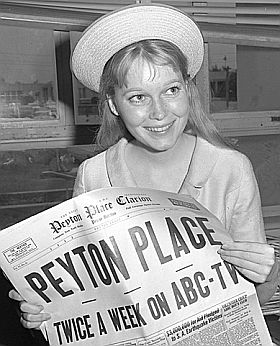
A17 year-old Mia Farrow holding a “Peyton Place newspaper” as she waits for 20th Century Fox TV contract approval in Santa Monica, CA courthouse. Photo, Los Angles Times, June 17, 1964.
Fears of a family values backlash faded as the show began running, as more “sex and sin” was implied than actually delivered. Although the book had some daring plot lines that involved incest, for example, the TV series went with less controversial themes such as teen pregnancy. The show was criticized for these and other sexual themes, but it still became a top hit. A month after Peyton Place premiered, ABC rose in the Nielsen ratings to No. 1 for the first time. Peyton Place was the first prime-time soap opera and it became something of a model for others that followed. The show developed a very loyal following of fans around the world. In fact, by June 1965, because of its success, it was increased to three showings a week. ABC considered developing a spin-off serial, and both CBS and NBC announced they were developing similar prime-time serials.

Some of the actors who appeared in the “Peyton Place” TV series, including at center, Barbra Perkin, Mia Farrow in white, and Ryan O’Neal, lower right.
Allison, meanwhile, becomes romantically involved with rich kid Rodney Harrington, played by Ryan O’Neal, who is pursued by another young woman named Betty Anderson, played by Barbara Perkin. Betty becomes pregnant, has a miscarriage, but marries Rodney without telling him about the miscarriage.
And through the series, there are a number of other characters who figure into one or more plot twists — Rodney’s brother, Norman Harringon; Rodney’s father, Leslie Harrington, who runs Peyton Mills; Dr. Michael Rossi, a young physician who has set up shop in Peyton Place; a tavern keeper’s daughter, Rita Jacks; Martin Peyton, the town’s patriarch — and more. In fact, in the long run of this series, more than 200 actors appeared in various primary and secondary roles.
A total of 514 Peyton Place episodes were broadcast between September 15, 1964 and June 2, 1969 — the early years in black in white, and later years in color.
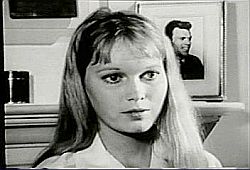
Mia Farrow as “Allison Mackenzie” in early episode of “Peyton Place” TV show, 1964.
Mia Farrow, meanwhile, received professional plaudits for her work in the1960s — a 1965 Golden Globe award for Most Promising Female Newcomer and a 1966 Golden Globe nomination. But her life by then had taken a new direction with her marriage to Frank Sinatra.
Frank & Mia
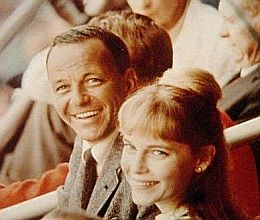
Frank Sinatra and Mia Farrow in the 1960s when her hair was still in the early "Allison Mackenzie" mode.
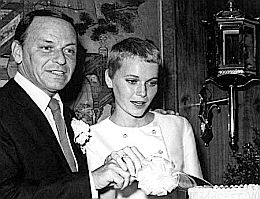
Frank Sinatra and Mia Farrow cutting their wedding cake, July 1966.

Part of the tabloid fare on the Sinatra-Farrow watch, 1966.
“…When I married Frank Sinatra, my father had recently died, and he [Sinatra] had just turned fifty, and people said, “Oh, you’re looking for a father.” It’s hard for me to, um, deny or confirm. But what I will tell you is that he was the coolest, handsomest, sexiest guy. I don’t think there are many women of any age who could have resisted him. He was utterly charming. Absolutely adorable. So you can talk father all you like — he wasn’t anything like my father….”
“…Frank Sinatra had a very strong moral structure. He was actually quite staid in certain respects, very much the Italian father. There was a part of him that would say, ‘break his legs,’ but there was a part of him that wouldn’t actually do it. And there was a part of him that was an excellent father and an excellent friend, who wouldn’t lie, who would do the right thing for other people and seek no reward….”
In the aftermath her break up with Sinatra, Farrow traveled to India in early 1968, where she spent time at the ashram of the Maharishi in Rishikesh studying transcendental meditation. This gathering gained worldwide media attention at the time due to the presence of the Beatles, Donovan, Mike Love of the Beach Boys, and Farrow’s younger sister, Prudence, who inspired John Lennon to write the song “Dear Prudence.”
Mia Farrow’s first leading film role was in Rosemary’s Baby, the June 1968 Roman Polanski horror classic. The film was a major critical and commercial success at the time and continues to be widely regarded as a classic of the horror genre. Rosemary’s Baby raised Farrow’s star power to new heights. For that role, she won a Golden Globe award for new star of the year; a David di Donatello Award for Best Foreign Actress; and a Golden Laurel Award. She was also nominated for Golden Globe best actress in a motion picture drama and a BAFTA best actress nomination.
By February 1969, she was on the cover of Time magazine with actor Dustin Hoffman, the two then cast in a new movie together, John and Mary. They were both fresh from the success of major films: she with Rosemary’s Baby and he, The Graduate. At the time in 1969, Rosemary’s Baby was ranked among the top 50 all-time movie hits and The Graduate was then the third largest money earner in movie history. In 1969, however, Farrow turned down the starring role of feisty teenager Mattie Ross in the western True Grit. In that role she would have played opposite John Wayne. The movie became a classic, with Wayne winning a Golden Globe and an Oscar, and also a BAFTA film award nomination for Kim Darby, who played Mattie. Farrow later admitted that not taking the True Grit role of Mattie was a major mistake.
1970s -1990s
In 1970, Mia Farrow married German-born composer André Previn, nearly 16 years her senior. During their nine-year marriage, the couple had three biological children and also adopted three orphans.
During the 1970s, Farrow also made 11 more films, among them: See No Evil (1971); Follow Me! (1972); The Great Gatsby (1974); Full Circle (1977); A Wedding, Avalanche, and Death on the Nile (all in 1978); and Hurricane (1979).
Through the 1970s, she was very much the Hollywood star in the public eye, landing on the covers of major magazines. In 1974, for example, she appeared on the covers of the Saturday Evening Post and the premier issue of a new magazine called People, in both cases dressed in period garb touting 1974’s The Great Gatsby.
By the end of the decade, the marriage of Mia Farrow and Andre Previn had ended.
In 1982, while filming A Midsummer Night’s Sex Comedy, Farrow fell in love with director Woody Allen. She wound up appearing almost exclusively in Allen’s films over the next ten years. She and Allen made 13 movies together: A Midsummer Night’s Sex Comedy (1982), Zelig (1983), Broadway Danny Rose (1984), The Purple Rose of Cairo (1985), Hannah and Her Sisters (1986), September (1987), Radio Days (1987), Another Woman (1988), Crimes and Misdemeanors (1989), New York Stories (1989), Alice (1990), Shadows and Fog (1991), and Husbands and Wives (1992). Farrow also played Alura, mother of Kara in Supergirl (1984) and voiced the title role in the animated film The Last Unicorn (1982).
|
Mia’s Children 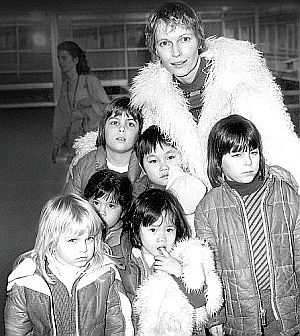 1978: Mia Farrow with some of her children: Mathew, 7, Sasha, 7, Soon-yi, 7, Lark Song, 5, Fletcher, 5, and Summer, 3. 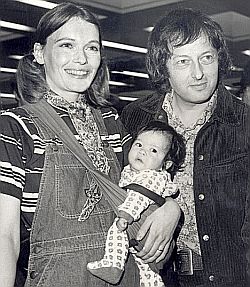 1973: A younger Mia Farrow with adopted baby Lark and then husband Andre Previn. |
Farrow worked less frequently in film during the 1990s, tending to her children, and later, the battle with Allen. Nonetheless, she appeared in leading roles in several notable films, included the Irish film Widows’ Peak (1994), and Miami Rhapsody and Reckless, both in 1995. She also appeared in several independent features and made-for-television films throughout the late 1990s and early 2000s. Farrow would later write the 1997 book, What Falls Away, her memoir of her Hollywood childhood, her two marriages, her TV and film careers, her children, and her years with Woody Allen. The book became a best seller and its literary quality was generally regarded as a cut above many other Hollywood memoirs.

Mia Farrow speaking at Oct 2008 Free The Children's ‘National Me to We Day,’ Toronto, Canada.
It is not exactly clear when Mia Farrow’s activism began, but she and others in London, including Vanessa Redgrave, participated in anti-war protest marches in 1970. Farrow’s first adoptions with second husband Andre Previn — two Vietnamese girls — also appear to have been a kind of activism and social statement by Farrow, occurring during the Vietnam War. “It was absolutely a time when we felt that, if you could [ adopt orphaned Vietnamese children], it would be a great thing..,” she explained in a 2006 interview with The Observer in London. Farrow has also stood with human rights leaders such as Nelson Mandela and Vaclav Havel. While in South Africa during 1997 and 1998, she traveled with Nelson Mandela to support the work of The Nelson Mandela Foundation Children’s Fund.
UNICEF, the United Nations Children’s Fund, ap- pointed her as Special Representative at the first Global Polio Partners Summit in September 2000. Farrow has worked extensively to draw attention to the fight to eradicate polio, a diseases which she survived as a child and also contracted by her son, Thaddeus. In recent years, Farrow has expanded her UNICEF and humanitarian work into other activities, mostly on behalf of children and refugees, especially in embattled regions, predominantly in Africa. She has become a determined and high-profile advocate for children’s rights and refugees.
Farrow & Darfur

Mia Farrow became a UNICEF ambassador in 2000, shown here with her son, Ronan, looking on at right.

Mia Farrow shows a photo to Sudanese children at a refugee camp in eastern Chad. August 5, 2008.
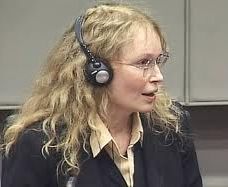
Mia Farrow testifying at trial of Charles Taylor, August 2010.
Other stories at this website featuring notable women and their careers, include: writer and ecologist Rachel Carson and her book, Silent Spring; Olympics star and pro golfer, Babe Didrikson; singer and TV celebrity Dinah Shore; rock star Tina Turner; and dancer and movie star, Cyd Charisse. The topics page, “Noteworthy Ladies,” offers additional story choices on women who have made their mark in various fields. Thanks for visiting – and if you like what you find here, please make a donation to help support the research and writing at this website. Thank you. – Jack Doyle
|
Please Support Thank You |
_____________________________
Date Posted: 16 November 2010
Last Update: 30 October 2019
Comments to: jdoyle@pophistorydig.com
Article Citation:
Jack Doyle, “Mia’s Metamorphases, 1966-2010,”
PopHistoryDig.com, November 16, 2010.
_____________________________
Sources, Links & Additional Information
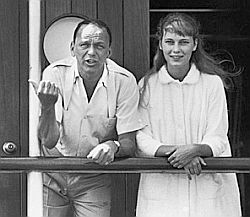 Frank Sinatra & Mia Farrow, 1960s. |
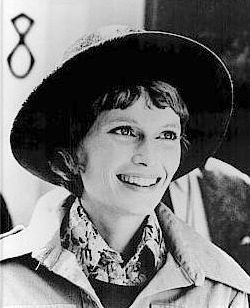 Mia Farrow, believed to be from 1967 TV film, “Johnny Belinda.” |
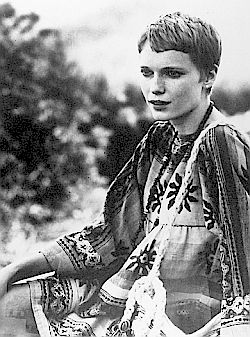 Mia Farrow, ABC-TV publicity photo, 1968. |
 Mia Farrow with Hal Holbrook during 1971 TV film, “Goodbye, Raggedy Ann.” |
 Mia Farrow on the first cover of “People” magazine, March 1974, then starring in “The Great Gatsby” w/ Robert Redford. |
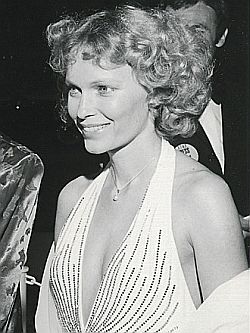 Mia Farrow at the 51st Annual Academy Awards in Los Angeles, CA, 1979. |
Humanitarian and Advocacy Information, Mia Farrow.org.
“The Best Books on Changing the World for Good Recommended by Mia Farrow,” FiveBooks.com, September 21, 2010.
Joel Whitney “Powerful Acts,” Mia Farrow Interview, Guernica, A Magazine of Art and Politics (NY, NY), July 2007.
Neil Docherty, “Mia Farrow’s Mission: A Movie Star on the Darfur Front Lines,” CBC News, October 10, 2007.
Paul Rusesabagina, “Mia Farrow,” Time, Friday, April 25, 2008.
Mia Farrow, “Person of the Year Nomination,” Time, December 15, 2008.
Sue Brower, “Peyton Place, U.S. Serial Melodrama,” Museum of Broadcast Communication, as of September 2008.
Tim Brooks and Earle March, “Peyton Place,” The Complete Directory to Prime Time Network and Cable TV Shows, 1946-Present, Eighth Edition, 2003, pp. 933-934..
“Peyton Place” (TV series), Wikipedia.org.
Leo E Litwak,”Visit to a Town of the Mind,” New York Times Magazine, April 4, 1965.
Thomas Thompson, with Bill Eppridge photos, “Mia,” Life, May 5, 1967, pp. 75-81.
“Mia Farrow and Her Director on Their Film Collaboration,” New York Times, January 22, 1984
Eric Lax, “Woody and Mia: A New York Story,” New York Times, February 24 , 1991. Eric Lax Is the author of Woody Allen: a Biography,(Alfred A. Knopf, 1992), from which this Times article Is adapted.
“Woody Allen Tells of Affair as Custody Battle Begins,” New York Times, March 20, 1993
“Farrow Says Daughter Became Distraught Over Allen’s Relentless Attention,” New York Times, March 27, 1993
“Doctor Recounts Threats By Farrow Against Allen,” New York Times, March 30, 1993.
“Allen Loses to Farrow in Bitter Custody Battle,” New York Times, June 8, 1993
Peter Pringle, “Melodrama of Many Acts; Profile – Mia Farrow,” The Independent (London), Sunday, February 9, 1997.
“Mia Farrow,” Wikipedia.org.
Kathryn Harrison, Book Review of Mia Farrow’s What Falls Away, “Intimate Strangers: Mia Farrow’s Memoir of Two Marriages, 14 Children and a Disastrous Affair with Woody Allen,” New York Times, February 23, 1997.
Mia Farrow, What Falls Away: A Memoir, New York: Nan A. Talese / Doubleday, 1997, 370 pp.
Samantha Power, “Remember Rwanda, but Take Action in Sudan,” New York Times, April 6, 2004.
Samantha Power, A Reporter at Large, “Dying in Darfur,” The New Yorker, August 30, 2004.
Gaby Wood, Interview with Mia Farrow, “I’ve Always Had a Sense of the Unworthiness of Myself,” The Observer (London), Sunday, January 29, 2006.
John H. Richardson, “What I’ve Learned: Mia Farrow,” Esquire, June 1, 2006
Gill Pringle, “Mia Farrow: ‘My Faith Helps Me Through Hard Times’,” The Independent (London), Friday, June 2, 2006.
Ronan Farrow and Mia Farrow, “The ‘Genocide Olympics’,” Wall Street Journal, March 28, 2007.
Jill Lawless, Associated Press, “Thousands Protest Darfur Crisis,” Washington Post, Sunday, April 29, 2007.
Sue Reid, “The Folly of Mamma Mia: Wouldn’t Mia Farrow be Better Off Helping Her Own Dysfunctional Family?,” Daily Mail (London, U.K), May 12, 2009.
“Frank Sinatra & Mia Farrow on What’s My Line?” You Tube video of Mia Farrow in the mid-1960s appearing as mystery guest on the TV quiz show What’s My Line? with Frank Sinatra serving as one of the show’s panelists during the time of their marriage.
“Who’s Who: Biographical Notes” (United Nations Goodwill Ambassadors, etc.), United Nations.
“Mia Farrow Testifies: Campbell Said Gift Was ‘Huge Diamond’,” Gallery, Washington Post, August 2010.
Edward Cody, “Naomi Campbell Testimony to War Crimes Tribunal: Not Clear Gift Was Diamonds,” Washington Post, Thursday, August 5, 2010
“The Influence of Writers and other Artists on Human Rights & Public Policy,”Spring 2009 Study Group: Art and Politics, Harvard University Institute of Politics, Harvard.Edu, Study group led by IOP Fellow Rose Styron. Session V: Guest: Mia Farrow: How the celebrity created by our great interest in film can be used to marshal political action, March 17th, 2009.
Sarah El Deeb, “Mia Farrow To Air ‘Darfur Olym- pics’,” HuffingtonPost.com, August 7, 2008.
Sam Rubin and Richard Taylor, Mia Farrow: Flowerchild, Madonna, Muse, New York: St. Martin’s Press, 1989.
Edward Z. Epstein and Joe Morella, Mia: The Life of Mia Farrow, New York: Delacorte Press, 1991.
Martha Duffy, “Books: Mia Farrow Tells Her Side,” Time, Monday, February 17, 1997.
“Farrow to Sign ‘What Falls Away’,” Los Angeles Times, March 5, 1997.
Charles Derry, “Mia Farrow,” Film Reference.com.
